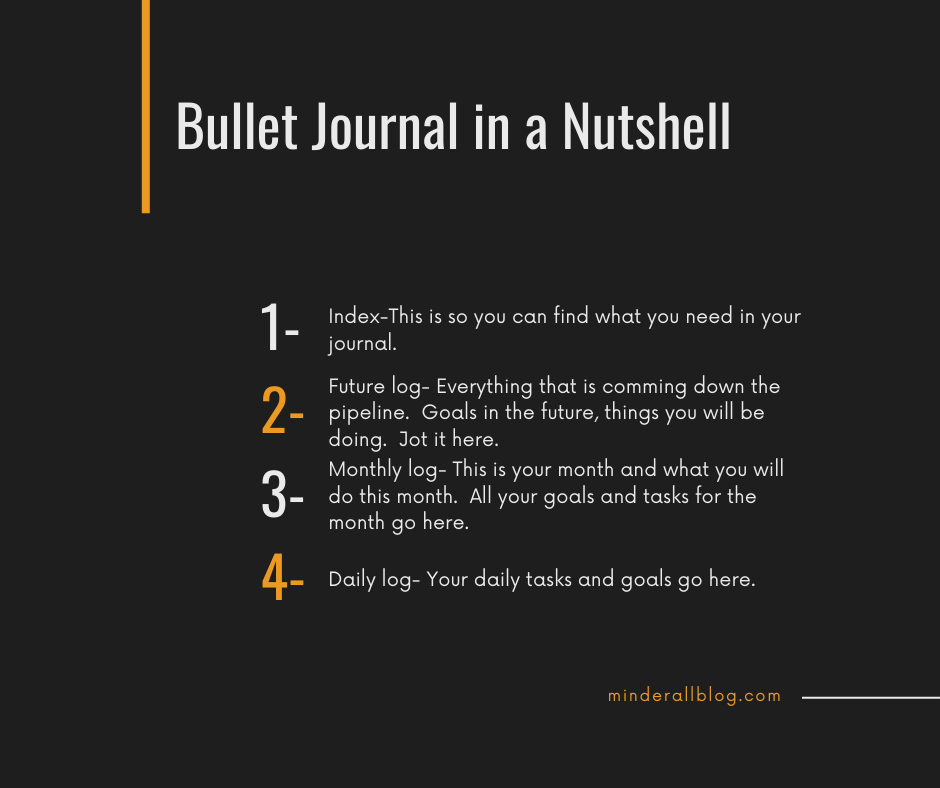The Ultimate Guide to the Bullet Journal

Why Your Chaotic Life Needs Bullet Journaling (And Why It’s Not BS)
Alright, let’s cut the crap and get real for a minute. You’re here because your life’s a mess, your to-do list is a joke, and you’ve probably tried a dozen ways to get things on track. Enter the bullet journal. It’s not just some fad your artsy cousin is into; it’s a legit way to reclaim your sanity. So, let’s dive into this no-nonsense guide to bullet journaling and see how it can make your life suck less.
What the Hell is Bullet Journaling Anyway?

Alright, let’s break this down. Bullet journaling, often abbreviated as ‘BuJo’, isn’t some sort of voodoo magic for the ultra-organized. It’s a method developed by a dude named Ryder Carroll, and it’s all about tracking the past, organizing the present, and planning for the future. But it’s more than just a fancy to-do list; it’s a customizable system that combines planning, doodling, tracking, and basically whatever else you want.
The Basics: More Than Just a Notebook
At its core, bullet journaling starts with a simple notebook and a pen. But this isn’t your average diary. It’s a mix-and-match of a planner, diary, sketchbook, and whatever else you need it to be. The key is its flexibility. You’re not stuck with pre-printed pages or specific layouts. You create what you need, when you need it.
The Index: Your Personal Table of Contents
This is where you start. An index is crucial. It’s your roadmap to finding all the gold you’re going to jot down in this thing. As you add pages to your journal, you update your index, so you always know where everything is. It’s like Google for your notebook.
Rapid Logging: The Bullet Journal’s Secret Sauce
This is where the ‘bullet’ part comes in. Rapid Logging is the method of using symbols to categorize and quickly log information. A dot might be a task, a circle an event, a dash a note. It’s shorthand for your brain. Think of it like texting yourself – quick, simple, no frills.
Modules: The Building Blocks

Modules are the different sections of your bullet journal. The four core ones are:
- The Index: We talked about this. It’s your guide.
- The Future Log: This is where you jot down events or tasks months in advance. It’s like a crystal ball for your schedule.
- The Monthly Log: A broad overview of a single month. Put your monthly goals, important dates – the big picture stuff.
- The Daily Log: Your day-to-day activities. This is where the nitty-gritty happens, the tasks, appointments, and random thoughts of daily life.
Collections: Personalizing Your Bullet Journal
Collections are pages where you track specific topics or tasks. This could be anything from books you want to read, fitness goals, mood trackers, or places you dream of traveling to. It’s like creating mini-apps within your journal for different aspects of your life.
Customization: Make It Your Own
This is where the magic happens. Your bullet journal can be as minimalist or as artsy as you want. Some people go full-on Van Gogh with their BuJos, while others keep it stark and simple. The point is, it’s yours. Tailor it to fit your life, your goals, and your personality.
Why It’s Not Just a Planner
So you might be thinking, “This sounds like a planner.” But it’s more than that. It’s a tool for mindfulness, a way to track your personal growth, and a method for organizing not just your schedule, but your thoughts and aspirations. It’s about making the chaos of everyday life a little more manageable and a lot more meaningful.
Bullet journaling is a system that grows and changes with you. It’s not about getting a pre-made solution; it’s about creating a system that works for your unique life. It’s about taking all the noise in your head and turning it into a symphony. Well, maybe not a symphony, but at least a decently organized playlist.
Reasons Why Bullet Journaling Isn’t Just Another Trendy Fad
You’re probably thinking, “Great, another productivity trend.” But hear me out. Bullet journaling isn’t about being trendy; it’s about getting your mess of a life organized. Here’s why it’s not just hot air:
- Kills Procrastination: Say goodbye to “I’ll do it tomorrow.” Bullet journaling puts your tasks right in your face, in ink. No escaping now.
- Clears Your Mental Mess: Dump all your thoughts, plans, and goals in one place. It’s like a brain detox.
- Unleashes Creativity: Who says organization has to be boring? Jazz it up. Make it yours.
- Adaptable: Your life changes, and so does your bullet journal. It’s the chameleon of planners.
How to Bullet Journal Like a Boss (And Not Screw It Up)
So you’re all set to start your bullet journal journey, and you want to nail it, right? Here’s how you do it without turning it into a glorified coaster.
Step 1: Gear Up – Choose Your Weapons Wisely
First things first, pick a notebook. Any notebook. But remember, this thing’s going to be your brain’s sidekick, so choose one that doesn’t make you cringe. Lined, dotted, blank pages? It’s your call. And grab a pen you actually like writing with. This isn’t the time for that half-chewed pen from the bottom of your bag.
Step 2: Set Up Your Bullet Journal Structure
Remember, your bullet journal is like a chameleon – it adapts. Start with these sections:
- The Index: This is your bullet journal’s control center. Everything you add gets logged here. It’s simple – just number your pages and list them in the index with a brief description.
- The Future Log: Think of this as your long-term planner. Here you jot down events, goals, and long-term tasks for the coming months.
- The Monthly Log: Break it down now to a monthly view. This is a snapshot of the month ahead. List your monthly goals, important dates, and things to keep an eye on.
- The Daily Log: This is where the action happens. Daily tasks, appointments, and random thoughts all go here. It’s the heart of your bullet journal.
Step 3: Embrace the Bullet Journaling System
- Use Rapid Logging: Remember those symbols? Start using them. Tasks, events, notes – give them each a symbol and keep it consistent.
- Migrate Wisely: Not all tasks are created equal. Some tasks will follow you like a lost puppy – migrate them to the next day or month. But be real with yourself. If you’re migrating the same task for the third time, ask yourself, is it really that important?
Step 4: Make It Personal (But Functional)
- Collections: These are your specialized pages. Want a page to track books you’re reading or movies to watch? Make a collection. It’s your bullet journal; tailor it to your life.
- Creativity is Key: Add some personality to it. Doodle, use colors, or stick to a minimalist black and white theme. Just remember, it’s a tool, not a piece of art (unless you want it to be).
Step 5: Review and Adapt
- Regular Reviews: Take a step back every now and then. What’s working? What’s not? Adjust your system as you go. Your bullet journal is a living document.
- Evolve Your Journal: As your life changes, so should your bullet journal. New job? Make a work section. Training for a marathon? Add a fitness tracker. It’s all about making your bullet journal work for you.
Step 6: Don’t Obsess Over Perfection
- It’s Not About Being Perfect: Screw-ups are part of the journey. Spilled coffee on a page? Turn it into a doodle. Wrote something in the wrong place? Find a creative way to cover it up. Your bullet journal is a reflection of your life – messy but beautiful.
Conclusion: Bullet Journaling as a Lifestyle
Remember, bullet journaling isn’t just about keeping track of your tasks and appointments. It’s about understanding your priorities, realizing your goals, and actually getting closer to them. It’s a tool for mindfulness and self-reflection, as much as it is for productivity. So embrace the process, make it your own, and watch how it transforms not just your daily schedule, but your entire approach to life and its chaos.
Key Considerations for Not Screwing Up Your Bullet Journal
You’ve got the basics down, and you’re ready to dive into the world of bullet journaling. But before you do, let’s talk about how to keep your bullet journal from turning into a hot mess. Here are some key considerations to keep in mind:
Stay True to the Purpose
- Remember Why You Started: This journal is meant to make your life easier, not add to your stress. Keep it functional. It’s a tool for organization and reflection, not just a pretty notebook.
- Function Over Flair: Sure, make it look nice if that’s your thing, but never at the expense of functionality. You’re here to get organized, not win an art contest.
Don’t Get Overwhelmed with Creativity
- Keep It Simple: It’s easy to fall down the rabbit hole of elaborate layouts and artistic pages, especially if you’re browsing through Pinterest or Instagram. Remember, your bullet journal doesn’t have to be a masterpiece. It’s more important that it’s useful and tailored to your needs.
- Evolve Gradually: Start with basic layouts and as you get more comfortable, slowly introduce new elements or artistic touches. Let your journal evolve with your experience.
Be Consistent but Flexible
- Routine is Key: Try to update your journal regularly. Whether it’s daily or weekly, find a rhythm that works for you and stick to it. Consistency is what turns bullet journaling from a chore into a habit.
- Adjust as Needed: If something in your journal isn’t working, change it. Don’t be afraid to ditch layouts or tracking methods that aren’t serving you. The bullet journal is all about adaptability.
Avoid the Perfection Trap
- Embrace Imperfections: Your journal will have mistakes – accept them. Don’t get hung up on making every page Instagram-worthy. Scribbles, crossed-out words, and coffee stains are all part of the journey.
- It’s a Personal Tool: Remember, this journal is for you and you alone. It doesn’t need to meet anyone else’s standards or expectations. Keep it personal and private if that helps you avoid the lure of perfection.
Reflect and Review Regularly
- Take Time to Reflect: Regularly look back at what you’ve accomplished and what you’ve learned. This reflection can provide valuable insights into your habits, productivity, and goals.
- Review for Efficiency: Every now and then, review your journal setup. Is it still working for you? Do you need to simplify your system or add new sections? Your life isn’t static, and neither should your bullet journal be.
Conclusion: It’s About the Journey
In the end, bullet journaling is as much about the journey as it is about the destination. It’s a personal tool for growth, reflection, and organization. By keeping these key considerations in mind, you can ensure that your bullet journal remains a valuable and effective companion in your daily life, helping you to navigate through the chaos with a bit more clarity and a lot less stress.
Taking it to the Next Level: Making Your Bullet Journal Not Suck
So, you’ve got the hang of the basic bullet journal setup, and you’re ready to take it up a notch. Here’s how you can elevate your bullet journaling game, making it not just a functional tool, but a powerhouse of productivity and creativity.
Experiment with Advanced Layouts and Techniques
- Dive into Layouts: Now that you’re comfortable with the basics, start experimenting with different layouts. Weekly spreads, mood trackers, or even meal planners – the possibilities are endless.
- Explore Time-Tracking Techniques: Consider incorporating time-blocking or pomodoro techniques into your journal. Check out our post on “Maximizing Productivity with Time-Blocking in Bullet Journals” for some inspiration and guidance.
Incorporate More Aspects of Your Life
- Holistic Approach: Start using your bullet journal to track not just tasks and appointments, but also your habits, moods, and even water intake. Our article, “Bullet Journaling for Health and Fitness: A Comprehensive Guide,” offers great tips on this.
- Mindfulness and Gratitude: Add a section for daily gratitude or mindfulness practice. This can transform your journal into a tool for mental well-being as well as productivity.
Personalize with Creativity and Flair
- Get Artsy: If you’re artistically inclined, unleash your creativity. Sketch, use washi tape, or experiment with calligraphy. Our post “Unleashing Creativity in Your Bullet Journal” is packed with ideas to inspire you.
- Themed Pages: Create themed pages for different months or seasons. This not only adds a creative twist but also keeps your journaling experience fresh and exciting.
Connect with the Bullet Journaling Community
- Join Online Forums and Groups: Engaging with the bullet journaling community can provide a wealth of ideas and support. Share your layouts, ask for feedback, and get inspired by others’ creativity.
- Participate in Challenges: Many bullet journal communities host monthly or weekly challenges. Participating in these can push your creative boundaries and introduce you to new techniques.
Utilize Your Bullet Journal for Goal Setting and Reflection
- Set Goals: Use your bullet journal for serious goal-setting. Break down big goals into actionable steps and track your progress. For more on this, check out “Goal Setting in Your Bullet Journal: The Ultimate Guide.”
- Monthly Reflections: At the end of each month, take time to reflect on what you’ve achieved, what didn’t work, and how you can improve. This reflection is crucial for continuous growth and development.
Integrate Digital Tools
- Hybrid Journaling: Don’t be afraid to mix digital tools with your analog journal. Apps for reminders or digital calendars can complement your bullet journal. For tips on balancing digital and analog systems, see “Hybrid Bullet Journaling: Best of Both Worlds.”
Conclusion: Your Bullet Journal, Your Rules
Remember, the beauty of bullet journaling lies in its flexibility. There are no hard and fast rules. Whether you keep it simple or turn each page into a work of art, the goal is to make it work for you. By experimenting, personalizing, and continuously adapting your bullet journal, you can transform it into an indispensable tool that not only helps you stay organized but also supports your personal growth and creativity.
Alternatives to Bullet Journaling (For the Rebels)
Not everyone’s cut out for bullet journaling, and that’s perfectly fine. Maybe you’ve tried it and it’s not your jam, or perhaps you’re just looking for different ways to stay organized and productive. Whatever the reason, there are plenty of alternatives out there that can do the trick. Let’s explore some of the best options:
Digital Planners and Apps
- Embrace Technology: In our digitally-driven world, apps and software can be fantastic tools for organization and productivity. Apps like Trello, Evernote, or Google Keep offer great ways to organize tasks, set reminders, and keep track of your life.
- Calendar Apps: If you’re looking for something straightforward, digital calendars like Google Calendar or Microsoft Outlook can be powerful tools for scheduling and reminders.
Pre-Made Planners
- Traditional Planners: For those who still love the pen-and-paper approach but want more structure, traditional planners are the way to go. They come with pre-defined spaces for daily, weekly, and monthly planning.
- Themed Planners: There are planners tailored to specific needs – fitness planners, academic planners, meal planners, etc. These can be great if you have a particular focus or goal in mind.
Mind Mapping
- Visual Planning: Mind mapping is a visual way of brainstorming and organizing your thoughts. It can be a fantastic alternative for those who think more in pictures than lists. Tools like XMind or MindMeister can get you started.
- Creative Freedom: Unlike bullet journals, mind maps don’t require a linear or structured approach, which can be liberating for the more creatively inclined minds.
Habit Tracking Apps
- Focused Approach: If your main goal is to build or break habits, dedicated habit-tracking apps might be what you need. Apps like Habitica, which gamifies habit-building, or Streaks, which focuses on maintaining long streaks of your habits, can be particularly motivating.
- Simplicity and Efficiency: These apps are designed to offer a quick and easy way to track daily habits without the need for setting up complex journal pages.
Note-Taking Software
- Digital Note-Taking: For those who are more into capturing information than organizing tasks, note-taking apps like OneNote or Bear could be ideal. They’re great for storing information, jotting down ideas, or even keeping a digital diary.
- Organization Features: Many of these apps offer organizational features like tagging, categorizing, and even basic task management.
Conclusion: Find What Works for You
The key to successful organization and productivity is finding a system that works for you. It might be one of these alternatives, a combination of a few, or something entirely different. The goal is to find a tool that resonates with your lifestyle and helps you achieve your objectives. Whether it’s the flexibility of a digital app or the tangibility of a pre-made planner, the best system is the one that you’ll consistently use and enjoy.
Wrapping Up: Why Bullet Journaling Changed My Life (And Can Change Yours)
So there you have it





